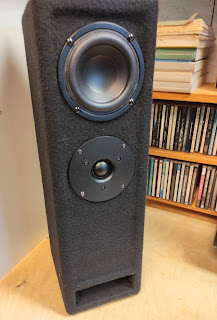Part3
As I mentioned in the previous post: I was getting annoyed by the overall group delay as it is introduced by the text book IIR (LR 24dB/oct) filtering.
So here's the experiment: home brew TL with a very cheap 4" speaker. I totally forgot to take pictures of the making, not that interesting at all: it is a standard 1/4 lambda backloaded TL with some folding.
Very similar to the PMC design
The big difference will be the filtering: I used one off my DSP boards to make a overall zero phase shift X-over using FIR filtering. How to do so will be a topic for a different series of post. Soon. Maybe.
While presenting them to my audio peers it became clear to us that there's no way back to IIR filtering once you have tasted the reverberant field as it is presented by a zero phase system..
But that wasn't the topic of this experiment. We where investigating the sonic properties of a Transmission Line. Funny coincidence: right at this moment the Amsterdam Dance Event is happening and all newspapers are full with interviews with the current stars of EDM. Accompanied illustrations show pictures of studios with big (PMC) transmission line monitors.So this is hot stuff at the moment.
Now how does a TL sonically compare to a different approach?
Very same speaker, different hornloaded tweeter but we can ignore that. Literally. We have been practising listening for some time.
In this small cabinet I used a digital implementation of the Linkwitz Transform to get some LF response squized out of that wee speaker.
In the STM32 part of this blog I did talk a bit about the intricacies of this.
So we now have two things to compare AFTER each other. As always when listening and evaluating audio stuff: you have to remember it for a few seconds. Which isn't simple and definitely needs some training..
How do they compare?
Purple line is close to the port of the TL (transmission line) while the green line is close to the speaker of the LT (linkwitz transform) closed box.
Clearly the TL has quite some lower response around 60 hz (again, such nice frequency) all though at the cost of a bit funky phase response.
Forget the resonances at 180, 300 (hey..odd harmonics..hmmm) they certainly spoil the fun in this experiment and are the main reason that some music really shines while other sounds horrific. Missing fundamental psycho-acoustics at play here.
But we are not finished yet.
I totally like that 60hz. From such a small box. So I made another, bit bigger TL with a 10" speaker. Right at this moment it is playing at my feet under my desk. Also at actual quiet levels it really does bring an extra dimension to the genre I am currently digging in:
(EDM is too boring for me)
So you can get an idea of the sonic landscape.
Now what about those pipe harmonics in this setup?
Well, very steep FIR filtering at 80 Hz proved to solve that.
How? By using down sampling to a sample frequency that doesn't take zillions of coefficients to get the desired resolution of the linear phase filter.
Naturally (a lot of) delay has to be added to the (high end) desktop speakers.
And now things get really interesting:
I never was a fan of 'separate' sub woofers. Also in live sound. The setting of delays from subs to mains or vice versa always is giving you grief when they are some distance apart. Most certainly if you understand what phase-alignment involves.
Why would that be as wave lengths around those frequencies are in meters? So how could some centimeters make a difference? Well maybe the (much higher in frequency) harmonic distortion produced by subs have to be in time with your main?
With the above very steep filtering I could, at least at lower levels, get rid of that distortion and now the sub is behaving as it should: it seems as if my wee desktop speakers are producing a tremendous amount of accurate bass. Most certainly with instruments I know well (like bass guitar)
I also tried a similar setup with a conventional cabinet, but that doesn't give you the same results: a TL has a lot more efficiency at the freq. of interest, meaning the cone has to move less and thus produces less distortion compared to an (augmented) closed box.
So that leaves only the quirky phase response (at 60-70hz) from a TL to be evaluated against program material. (I could differentiate it to get the groupdelay to get a better insight)
Let's see..
..Audio reproduction is a construct..





